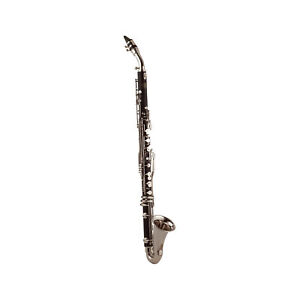


Calcagno: Labyrinth Music Perseverance Pentaweb Parallel Events Cybernetic Brotherhood Escapeless Seven Virtues of Bushido. I found the second half of the album particularly enjoyable, as Salakka sounds most at home playing these songs.

His use of multitracking adds an extra element to his recordings, and his arrangements for low clarinet ensembles are especially effective.

Teppo Salakka has presented us with another very fine album of enjoyable music for contra-alto clarinet. It is a fitting portrayal of the elephant. The larger bore of this instrument can really be heard, with its broader tone compared to the Selmer we heard on the rest of the album. The album closes with Saint-Saëns L’Elephant played on the Leblanc contra-alto and accompanied by three bass clarinets. Salakka’s musicality really shines through on this piece with his delicate phrasing. It appeared on Salakka’s first contra-alto clarinet album with piano, but this time is arranged for two contra-altos and bass clarinets. The following song is Waltz for a Little Girl, also by Sarmanto. Salakka keeps the playing light and sounds very comfortable. The only track with piano on the album is Heikki Sarmanto’s Old San Juan, a jazz song originally written for the double bass. The contra-altos play the prominent role, with the bass clarinets situated further back in the mix, although I think I would prefer it to be overall a bit more balanced so I could hear the jazz harmonies better. Toivo Kärki’s popular 1944 Finnish tango Siks oon mä suruinen has been arranged for two contra-altos (Selmer playing the melody, Leblanc playing the bass line) and three bass clarinets. Salakka plays the melody on the contra-alto in the upper register, where the instrument has a rather unique timbre, and has arranged an accompaniment of four bass clarinets. This singing quality continues in Pekka Kuusisto’s song Kiestinki. Salakka demonstrates his ability to make the contra-alto clarinet sing beautifully in Sven-David Sandström’s short Kyrie for clarinet. Salakka brings out the contrasts in dynamics and mood of the piece nicely. In Johan Kvandal’s Fantasy for clarinet, the melodies wind themselves throughout the instrument and into some more fast finger patterns. There are some quick, articulated phrases that jump around the instrument that Salakka makes sound effortless. Jindrich Field’s clarinet piece, Suite Rhapsodica, highlights both the high and low range of the instrument simultaneously with writing that invokes the feeling of two instruments playing in call-and-response. 4 is more rhythmical and reaches into the altissimo register, a potentially dangerous range on this instrument, but Salakka maneuvers it skillfully. 2 for bass clarinet, and he has included Solo No. On Fragmented Visions, Salakka recorded Jakob Veislev’s Solo No. The interplay between them is good and Salakka plays with a beautifully rich tone. The second track is Neil Butterworth’s Theme & Variations for two clarinets, played on two Selmer instruments. I think the effect works, resulting in a more three-dimensional sound than if he was playing alone, although sometimes the parts are not executed exactly together. Salakka decides to play two different contra-altos here: a Selmer and the much larger-bore Leblanc, sometimes in unison and sometimes in octaves, to try to better capture the essence of the original ensemble work. The first track is Michael Nyman’s Manhatta, originally an ensemble work composed for a silent film but available as a solo bass clarinet piece. There is still, as with his previous release, virtually no music actually written for this instrument, so he has included a number of transcriptions of solo works for clarinet, bass clarinet and double bass as well as multitracking some duos and songs with bass clarinet ensemble accompaniments. He has now released a follow-up album, Urban Visions. In 2017 Finnish clarinetist Teppo Salakka released the first-ever album of solo classical contra-alto clarinet music, Fragmented Visions, an album I had the pleasure of reviewing for The Clarinet. Sarmanto: Old San Juan and Waltz for a Little Girl C. Feld: Introduction (Suita Rhapsodica) and Aria (Suita Rhapsodica) S.D. Butterworth: Theme and Variations for Clarinet Duo J. Teppo Salakka, bass and contrabass clarinets, piano. Printed copies of The Clarinet are available for ICA members. Originally published in The Clarinet 49/2 (March 2022).


 0 kommentar(er)
0 kommentar(er)
